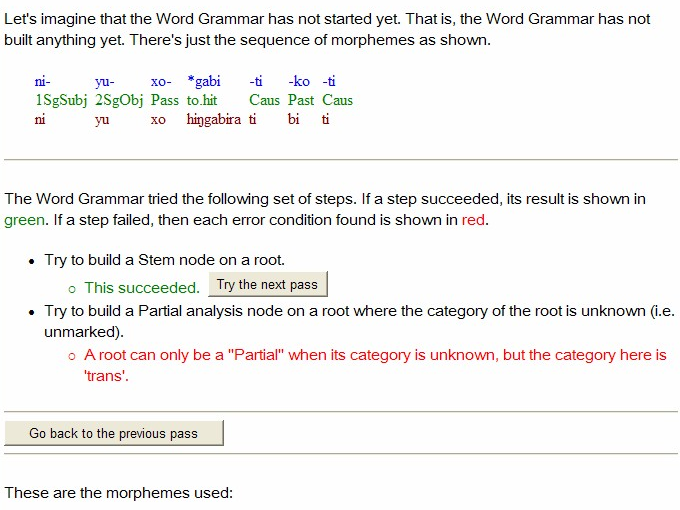
In the Try a Word dialog box, one of the paragraphs reads as follows (emphasis added):
"The Word Grammar tries to build a word in a number of ways in various kinds of steps. This tool shows what happens at a particular pass. It shows all the steps that the Word Grammar tried at this pass. Look for a step that would be reasonable given your understanding of how the wordform should be parsed. If such a step is shown as succeeding, click the 'Try the next pass' button to see the next pass. If such a step failed, read the description of the failure(s) and try to figure out how to correct it."
The word grammar "builds" a word from the stem outwards. If you click the Try the next pass button, it displays what it has done in the previous pass(es). Each pass builds more of the word structure.
This example is for the Kalaba word niyuxogabitikoti.
Notice, in the example that follows, how the bracketing [ ] outlines how the stem is being built. First the brackets are around only a root, then around a root and suffix, and then around a prefix, root, and suffix. Thus, each pass builds more of the word structure.
To see how the Try the next pass feature works, we can begin with this page:
|
Allomorph |
Type |
Other info |
|---|---|---|
|
ni- 1SgSubj ni |
inflectional affix |
Slot = (Subject) |
|
yu- 2SgObj yu |
inflectional affix |
Slot = Object |
|
xo- Pass xo |
derivational prefix |
From category = bitrans To category = trans To inflection class = 2 |
|
*gabi to hit higabira |
root |
Category = trans Inflectional class = 1 |
|
-ti Caus ti |
derivational suffix |
From category = trans To category = bitrans To inflection class = 1 |
|
-ko Past bi |
inflectional affix |
Slot = Tense |
|
-ti Caus ti |
derivational suffix |
From category = intrans To category = trans To inflectional class = 1 |
Clicking the Try the next pass button on the first success results in the following:
Then, clicking the Try the next pass button on the new first success results in the following:
Then, clicking the Try the next pass button on the new first success results in the following: